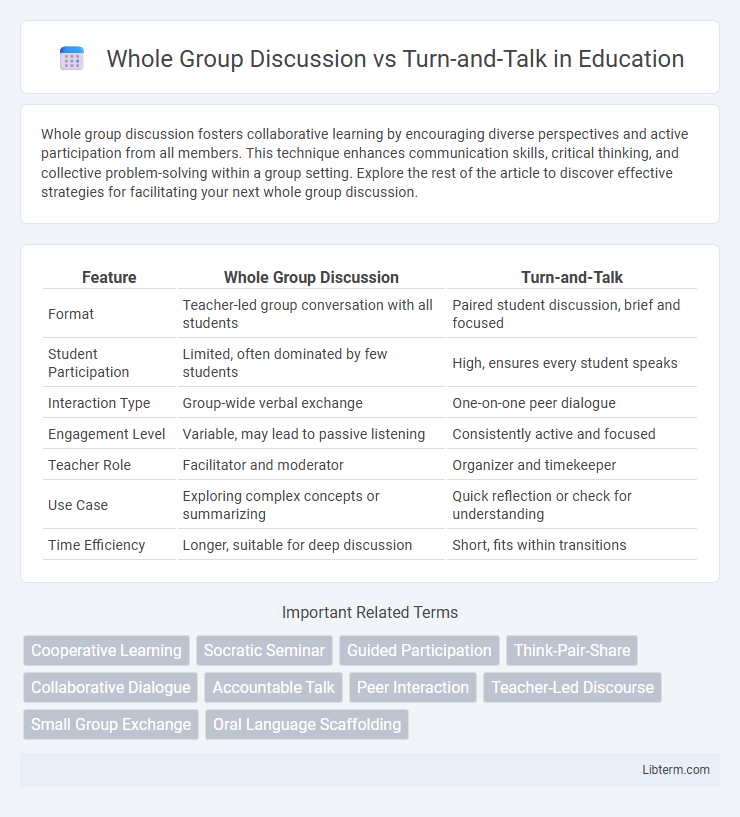Whole group discussion fosters collaborative learning by encouraging diverse perspectives and active participation from all members. This technique enhances communication skills, critical thinking, and collective problem-solving within a group setting. Explore the rest of the article to discover effective strategies for facilitating your next whole group discussion.
Table of Comparison
| Feature | Whole Group Discussion | Turn-and-Talk |
|---|---|---|
| Format | Teacher-led group conversation with all students | Paired student discussion, brief and focused |
| Student Participation | Limited, often dominated by few students | High, ensures every student speaks |
| Interaction Type | Group-wide verbal exchange | One-on-one peer dialogue |
| Engagement Level | Variable, may lead to passive listening | Consistently active and focused |
| Teacher Role | Facilitator and moderator | Organizer and timekeeper |
| Use Case | Exploring complex concepts or summarizing | Quick reflection or check for understanding |
| Time Efficiency | Longer, suitable for deep discussion | Short, fits within transitions |
Understanding Whole Group Discussion
Whole Group Discussion promotes deeper comprehension by allowing all participants to engage simultaneously, fostering diverse perspectives and collaborative learning. It enhances critical thinking through dynamic exchange and real-time feedback, supporting the development of higher-order cognitive skills. This method contrasts with Turn-and-Talk, which limits interaction to smaller pairs, potentially restricting the breadth of shared insights and collective understanding.
Defining Turn-and-Talk Strategies
Turn-and-Talk strategies involve pairing students to discuss specific questions or topics briefly, promoting active engagement and deeper understanding through peer interaction. This approach enables immediate verbal processing and allows every student to voice their thoughts in a low-pressure setting. Unlike Whole Group Discussion, which involves open dialogue among all participants, Turn-and-Talk ensures equitable participation and helps scaffold cognitive processing before broader sharing.
Key Differences Between Whole Group and Turn-and-Talk
Whole Group Discussion involves all participants sharing ideas simultaneously, fostering collective engagement and diverse perspectives in a single conversation. Turn-and-Talk pairs individuals to exchange thoughts more intimately, promoting deeper reflection and active listening before sharing with the larger group. The key difference lies in the scale and interaction style: Whole Group emphasizes broad participation, while Turn-and-Talk prioritizes focused, smaller-scale dialogue.
Benefits of Whole Group Discussion
Whole Group Discussion fosters diverse perspectives by engaging all participants simultaneously, enhancing collective critical thinking and deeper understanding of complex topics. It encourages active listening and the development of communication skills through dynamic interaction and immediate feedback. This approach supports a unified learning experience, making it ideal for synthesizing ideas and building consensus within educational or professional settings.
Advantages of Turn-and-Talk Activities
Turn-and-Talk activities encourage active student participation by providing every learner with the opportunity to articulate their thoughts in a low-pressure environment, fostering deeper comprehension and critical thinking. This collaborative interaction enhances speaking and listening skills while promoting peer learning, which can be especially beneficial in diverse classrooms. Turn-and-Talk also allows for immediate feedback and clarification, supporting differentiated instruction and increasing overall student engagement compared to Whole Group Discussions.
When to Use Whole Group Discussion
Whole Group Discussion is most effective for engaging the entire class in exploring complex topics that benefit from diverse perspectives and collective problem-solving. It is ideal when introducing new concepts, synthesizing information, or facilitating debates that require shared understanding and critical thinking. This strategy supports developing communication skills and encourages students to listen actively and respond thoughtfully within a collaborative learning environment.
Ideal Scenarios for Turn-and-Talk
Turn-and-Talk is ideal for quick idea sharing, allowing students to process information individually before articulating thoughts to a peer, which enhances comprehension and verbal skills. This strategy works best in classrooms aiming to increase student engagement and provide equal speaking opportunities without the pressure of whole group settings. It is particularly effective in larger classes or when introducing complex topics that benefit from peer discussion before full class analysis.
Challenges of Whole Group Discussion
Whole Group Discussions often face challenges such as limited student participation, as dominant voices can overshadow quieter individuals, reducing diverse perspectives. Time constraints can hinder deep exploration of topics and disrupt class pacing. Managing varying attention spans and maintaining engagement across a large group requires skilled facilitation to prevent off-topic conversations and ensure equitable contribution.
Common Pitfalls of Turn-and-Talk
Turn-and-Talk activities often face challenges such as uneven student participation and off-topic conversations, which can limit meaningful engagement. Students may struggle with staying focused or feel uncomfortable sharing ideas in pairs, reducing the effectiveness of peer interaction. Unlike whole group discussions, Turn-and-Talk requires careful monitoring and clear instructions to ensure productive exchanges and maximize learning outcomes.
Blending Both Approaches for Effective Learning
Blending Whole Group Discussion with Turn-and-Talk strategies maximizes student engagement and deepens understanding by balancing collective insight and individual reflection. Whole Group Discussions promote diverse perspectives and critical thinking on complex topics, while Turn-and-Talk allows students to articulate ideas and process information in smaller, less intimidating settings. Integrating both approaches creates a dynamic learning environment that supports active participation, reinforces comprehension, and accommodates varied learning styles.
Whole Group Discussion Infographic

 libterm.com
libterm.com